

 |
 |
Translator's Note
This is a translation of one of the earliest A. K. Skvortsov's contributions to Salicology. Although the article
was published about 50 years ago, it still retains its innovative value. The translation was initiated and edited
(in part) by Dr. George Argus, to whom it owes clarified and updated terminology adapted to the English usage.
The article consists of introduction, key to 17 species from European Russia, key to the same species in the
absence of floriferous buds, and descriptions of the species.
In the Russian literature, there exist a number of manuals meant for tree and shrub identification during the wintertime (Turskiy and Yashnov 1908, Wolf 1908, Ilyin 1925, Opredelitel Drevesnykh Porod 1940, Akimova 1950). However, it is very difficult to apply all these manuals (including the most comprehensive one by Wolf) to identification, because the list of characters in use is far from sufficient and also because the limits of character variability are not adequately determined. Neither Nilson's article (Nilson 1908), which is the best among foreign works, treats this problem sufficiently enough: many critical characters are omitted there.
To make the winter identification of Russian willows of the temperate climate belt more convenient and precise is the goal of this work. A number of new characters are introduced here, most of them describing the bud scales and bud contents. During the study, special emphasis was laid on the evaluation of variability ranges of the characters under consideration. A special key to willows in the absence of floriferous buds is presented tentatively.
The work is based primarily on observation of willow populations in nature as well as studying live material collected by the author mostly in Moscow Oblast and also around the cities of Vladimir and Voronezh. Material on some few species was kindly provided by N. Vinogradov (Galichya Gora Preserve, Lipetsk Oblast). The author also observed nine of the species during the wintertime in the Urals (vicinity of the Denezhkin Kamen). The descriptions of the European Russian plants proved to be likewise valid for the material from the Urals.
While collecting plants for the purpose of winter identification, one should first of all pay attention at their habit and size. Then, it is necessary to find out if all the buds look the same or some of them, the floriferous (flower) ones, are larger than others. If this is the case, then one has to make sure that the branchlets [Note 1] with the larger buds are included in the collection. It makes sense to cut well developed shoots and avoid weak and short ones, which are more typical of the inside, shaded parts of crowns. Neither the nourishing, oversized shoots nor broken or otherwise damaged ones are suitable for the purpose. In case all buds look alike and there is no way to figure out on the spot if there are some floriferous ones among them, one should merely take a few branches from the upper, more lighted part of the crown. In addition to branchlets, it is useful to take some fragments of two-year-old branches. Finally, one should check if there is any striation on the wood under the bark of the older, three- to six-year-old branches. All identifications are to be performed on live material whenever possible; otherwise, one has to boil the buds soft.
The branch diameter should be measured above the fourth bud, counting from the top of the branchlet. Vegetative buds located at the distal part of the branchlet or in-between the floriferous ones are the most typical, and they are those described in the keys. To consider the contents of a bud, one should cut it off with a razor and remove the bud scale first ripping it on the abaxial (back) side with a needle.
While collecting and identifying plants, one should always keep in mind that abnormalities are quite common in buds. Particularly, various illnesses and predators (especially insects) may induce either bud deformation or scale dying in species that normally retain live bud scales through the winter. Occasionally, additional small budlets develop inside the bud, laterally of the leaf primordia and catkin primordium. As a result, the base of the bud becomes dilated, the entire bud attaining a shape close to conoidal. If the growth of the bud contents goes on more slowly than that of the bud scale, then the bud gains a more or less flattened beak. Normally, the beak is only typical of some few species: S. phylicifolia, S. acutifolia, S. lapponum, and S. triandra.
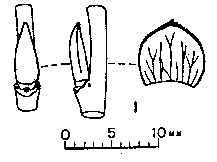 1. Salix pentandra L. B a y - l e a f w i l l o w
1. Salix pentandra L. B a y - l e a f w i l l o w
A tree, mostly of moderate size, rarely attaining the height of S. alba and S. fragilis, growing in wetlands, wet shrub thickets, on moist wood clearings and margins, sometimes near water. This species expands,
flowers, and ripens much later than all other willows in this country. Seeds disperse in the fall and partially even during
the wintertime; dry catkins always abundantly persist on female trees in winter. Branchlets 1.5–2 mm thick, glabrous, shiny, as if varnished, their color ranging from yellowish and yellow-brown to dark red-brown.
Stipule scars extremely small. Two-year-old branches more light colored. Buds up to 8×3 mm; positioned at acute angle to branchlets; deltoid-lanceoloid or conoidal; apices acute, either straight or recurved;
lateral carinas distinct (additional adaxial and abaxial carinas sometimes make buds look nearly four-angled); glabrous, shiny,
yellowish to dark red-brown. Bud scales dead, however, usually with a narrow stripe of alive tissue, which is differently colored, at base; scale veins dark. Outermost leaf primordium brownish or reddish, broad (when spread, its breadth is equal or exceeding length), with a few parallel veins starting from
base. Inner primordia green, gradually becoming narrower, glabrous, their margins sericeous, midribs distinct, veins pinnate. Floriferous buds
contain 5–8 leaf primordia. Catkins green, puberulent.
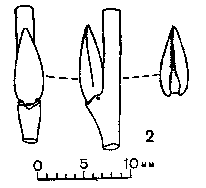 2. Salix fragilis L. B r i t t l e w i l l o w, c r a c k - w i l l o w
2. Salix fragilis L. B r i t t l e w i l l o w, c r a c k - w i l l o w
A tree, often very large, with a wide crown. Common at wet places, near water, and on residential lots.
Branchlets 1.5–2 mm thick, glabrous, rarely somewhat puberulent in distal parts, light colored, grayish-yellow, sometimes with greenish
tint. Stipule scars small, conspicuous. Two-year-old branches more grayish, dull; older branches gray, with greenish tone. Buds on average 7×2.5×2 mm (up to 9×3×2.5 mm); either accumbent to branchlets or positioned at acute angle; lanceoloid, narrowly
deltoid-lanceoloid, or conoidal; their apices either straight or curved to branchlets; lateral carinas distinct, adaxial and
abaxial carinas often present; surface glabrous, more or less shiny; in autumn yellowish, concolorous to branchlets, later
(when bud scales die) becoming blackish-tawny to black (narrow yellowish stripe of live tissue may remain at base of scale).
Outermost primordium very broad, almost round when spread, completely embracing inner primordia, sericeous at margin, glabrous on inside, on outside
either glabrous or not, with a few parallel veins starting from its base; inner primordia gradually becoming narrower and less pubescent, their venation usually pinnate. Floriferous buds contain mostly 4–5 leaf
primordia. Catkins densely sericeous.
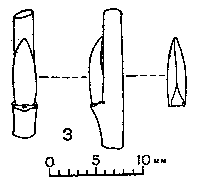 3. Salixalba L. W h i t e w i l l o w
3. Salixalba L. W h i t e w i l l o w
A tree, often very large, with a wide, frequently weeping crown on banks of rivers or other water bodies and at residential lots.
Branchlets 1–1.5 (rarely 2) mm thick, at least part of their surface sericeous or tomentulose, (rarely branchlets completely glabrous);
olivaceous or, more often, reddish or brownish colored. Stipule scars small. Two-year-old branches mostly grayish or somewhat brownish. Buds on average 7×2×1.3 mm (to 9×2.5×1.5 mm); mostly accumbent to branchlets; cylindric-lanceoloid, obtusish or acutish, flattish;
apices either straight or curved to branchlets; lateral carinas distinct; surface mostly pubescent (rarely glabrous), concolorous
to branchlets. Bud scales alive, soft, greenish on inside, their veins pale. Outermost primordium usually reddish, fully embracing inner primordia, glabrous on inside, sericeous on outside; inner primordia gradually narrowing, often partly or even completely glabrous. Venation of all leaf primordia appears uniform. Floriferous
buds usually contain 4–5 leaf primordia. Catkins generally green in color, their pubescence not dense; imbricate bract pattern visible underneath pubescence.
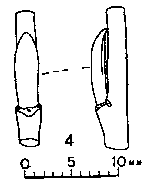 4. Salixtriandra L. A l m o n d - l e a v e d w i l l o w
4. Salixtriandra L. A l m o n d - l e a v e d w i l l o w
A medium-sized to tall shrub up to 3 m, found mostly near water, but also occurring at any moist places, particularly on sand.
Branchlets 1.2–1.8 mm thick, glabrous, yellow-olivaceous, tawny, fulvous, or rufescent, but without red or bright brown colors. Stipule scars large (to 1 mm). Two-year-old branches of lighter, grayish tone. Buds on average 7×2×1.3 mm (length may vary from 4 to 9 mm, width is more constant: seldom less than 1.5 mm); accumbent to branchlets,
or positioned at acute angle, or else narrow slots present in-between buds and branchlets; cylindric or lanceoloid; apices
obtusish, often forming flat beaks, either straight or somewhat curved to branchlets; lateral carinas distinct; surface glabrous,
generally concolorous to shoots, but often of brighter color: yellow, sometimes even orange or brown. Bud scales alive, soft, light-colored on inside, their veins pale. Leaf primordia ovate or lanceolate, outermost primordium not embracing inner ones, all primordia densely long-sericeous on outside, glabrous on inside. Floriferous buds contain 3–6
leaf primordia, all of them shorter than catkin. Catkins long-sericeous.
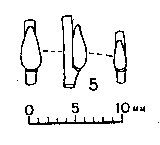 5. Salixmyrtilloides L. B i l b e r r y w i l l o w
5. Salixmyrtilloides L. B i l b e r r y w i l l o w
A lowshrub (0.2–0.6 m) restricted to wetlands.
Branchlets not more than 1 mm thick, glabrous or with sparse indumentum on distal parts, mostly reddish, brownish, rufescent, sometimes
violet-brown, rarely greenish. Stipule scars extremely small, inconspicuous or obsolete. Two-year-old branches glabrous, grayish. Wood in old branches without striation. Floriferous buds on average 3.5×1.5×1 mm; usually accumbent to branchlets; ovoid-lanceoloid, sometimes (when dilated right from base) deltoid-lanceoloid,
obtusish; surface glabrous, generally concolorous to branchlets. Floriferous bud scales usually dead, brownish on inside, their veins dark. Leaf buds similar to floriferous in shape and color, but smaller: 2–3 mm long and sometimes also somewhat slenderer; their surface
glabrous (seldom glabrescent); leafbudscales usually alive. Leaf primordia ovate-lanceolate or lanceolate, sericeous on outside, glabrous on inside. Floriferous buds contain 4–7 leaf primordia, all
longer than catkin. Catkins short (1.5–2 cm), glabrescent; imbricate bract pattern visible underneath sparse trichomes (bracts obtuse).
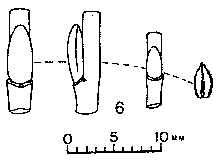 6. Salixnigricans (Sm.) Enand.
[S. myrsinifolia Salisb.]
6. Salixnigricans (Sm.) Enand.
[S. myrsinifolia Salisb.]
B l a c k e n i n g w i l l o w
A shrub of variable size, commonly growing in a variety of different habitats.
Branchlets 1–1.8 mm thick, their indumentum variable: from uniform, dense, and rather long (nearly velutinous) to tomentulose, or else
branchlets mostly (but not completely) glabrous. Branchlet color extremely variable: green, orange, fulvous, or reddish-brown.
Stipule scars small, but usually distinct. Two-year-old branches as well as older branches dull, grayish, or somewhat greenish. Wood in old branches without striation. Floriferous buds 4–7 mm long, up to 3 mm broad, to 2.5 mm thick; ovoid or lanceoloid; mostly obtuse, rarely acutish (even more rarely attenuating
into straight beak); surface more or less covered with trichomes, mostly with cluster of longer trichomes at bud base, on
its abaxial side; color variable, usually in same range as branchlet color, but often brighter. Bud scales alive, soft, pale green on inside. Leaf buds smaller, up to 5×2.5×1.5 mm; similar to floriferous buds in shape or else nearly cylindric, obtuse, and somewhat more flattened
than floriferous ones. Leaf primordia ovate-lanceolate or lanceolate, sericeous at margins, glabrous on inside, sericeous at midrib on outside, with one green
stripe on either side of midrib (observe this character carefully: green stripes may appear indistinct or midrib may be glabrescent).
Floriferous buds contain 2–4 leaf primordia. Catkins densely sericeous.
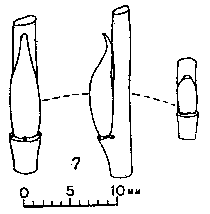 7. Salix phylicifolia L. T e a - l e a f w i l l o w
7. Salix phylicifolia L. T e a - l e a f w i l l o w
A shrub 0.5–2 m tall that occurs in moist habitats in the forest belt (within the distribution limits of the European spruce).
Branchlets to 2 mm thick, glabrous, olivaceous-tawny or brown, sometimes with a dark violet tint. Stipulescars distinct. Two-year-old branches colored almost similarly to branchlets or somewhat more grayish-olivaceous. Floriferous buds (7–13)×(2.5–3.5)×(2–3) mm; accumbent to shoots or somewhat recurved at distal parts; lanceoloid or ovoid, attenuated into
flattish, mostly recurved beaks; glabrous or glabrescent; concolorous to branchlets or somewhat more yellowish; their scales
alive. Leaf buds up to 6(7)×2 mm, lanceoloid or ovoid, flattish, their apices often recurved as in floriferous buds. Leafprimordia (both in floriferous and leaf buds) ovate or lanceolate; glabrous on inside, sericeous at margins, on outside either glabrous
or pubescent along midrib and with glabrous stripe on either side of midrib; rarely outermost primordium completely pubescent
on its outside, and then only inner primordia at least partially glabrous on outside. Floriferous buds contain 1–3 leaf primordia.
Catkins densely sericeous; however, bract apices are frequently visible through indumentum at proximal parts of catkins.
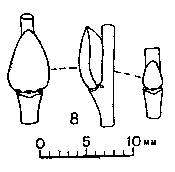 8. Salix aurita L. E a r e d w i l l o w
8. Salix aurita L. E a r e d w i l l o w
A shrub of medium size (0.5–2 m) distributed at wood clearings and moist habitats on watershed plateaus; uncommon in the chernozem belt.
Branchlets 1–1.5 mm thick, dark red, brown-red, rarely brownish, moderately tomentulose, usually glabrous in their proximal parts. Stipule scars distinct (up to 1 mm). Two-year-old branches more gray and dull, occasionally with some obsolete remnant tomentum. Wood in old branches with striation. Floriferous buds (4–7)×(3–4.5) mm; accumbent to branchlets; dilated right from base, deltoid-ovoid, somewhat flattened on adaxial side; their
lateral carinas distinct; apices obtusish, somewhat recurved; surface glabrous or with sparse indumentum; color dark red or
brownish-red, rarely olivaceous, with brownish-red burn; their scales alive, soft, pale on inside. Leaf buds appressed, ovoid to orbicular-deltoid, their scales also alive. Leaf primordia lanceolate, glabrous on inside, uniformly sericeous on outside. Floriferous buds contain 4–7 leaf primordia. Catkins densely sericeous.
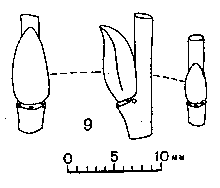 9. Salix cinerea L. G r a y s a l l o w, a s h w i l l o w
9. Salix cinerea L. G r a y s a l l o w, a s h w i l l o w
A shrub up to 2–3 m tall, confined mostly to moist depressions, such as gullies, ravines, sedge wetlands; much more rare on elevated
surface elements.
Branchlets 1.5–2 mm thick; often ribbed due to longitudinal furrows (on fresh material!); densely tomentulose, occasionally nearly velutinous;
tomentum uniformly covering branchlets, at least on their distal parts (and often all the way down to proximal parts); glabrous
areas occasionally present on proximal parts. Branchlet color gray or blackish-gray, occasionally with dull brownish tint.
Stipule scars distinct, often closely approximating leaf scars and nearly connate with them. Two-year-old branches also gray or blackish gray, dull, usually with some remnant indumentum. Wood in old branches with striation (which is obvious even without bark peeling, since striae on wood have corresponding furrows
on bark, i. e., bark thinned at places of wood striae). Floriferous buds about 5(6–11)×(3–4.5)×up to 4 mm; lanceoloid or ovoid; their distal parts more or less deviating from branchlets, apices
recurved; indumentum first dense, much of it disappearing with time, so that buds become nearly or even completely glabrous;
color brownish or rufescent-brown. Floriferous bud scales dead. Leaf buds about (3–4)×2.5 mm, ovoid or deltoid-ovoid, mostly acutish, frequently with apices somewhat recurved, covered with indumentum;
leafbudscales mostly alive, rarely dead. Leaf primordia lanceolate, uniformly covered with indumentum on outside, glabrous on inside. Floriferous buds contain 3–7 leaf primordia.
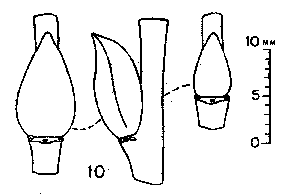 10. Salix caprea L. G o a t w i l l o w
10. Salix caprea L. G o a t w i l l o w
A small or medium-sizedtree that may attain a shrub habit if its trunk is cut or damaged, particularly, if the damage occurs multiple times; growing
in woods, coppices, dry meadows at forest edges, as well as along roads and on residential lots; occasionally on river banks,
but avoiding wetlands.
Branchlets 2–3 mm thick, usually tomentulose only at distal parts (occasionally branchlets completely glabrous); greenish on one side,
with brownish or reddish-brown burn on other side, rarely completely green or completely brown (but in the latter case green
tint on one side present at least on branches of previous year). Stipule scars distinct. Two-year-old branches look similar to branchlets; older branches of duller color, however, retaining greenish tint for many years (which makes this species different from S. aurita and S. cinerea). Wood in old branches without striation. Floriferous buds (6–15)×(4–8)×(2–5) mm; ovoid or deltoid-ovoid, acute, in their distal parts deviating from branchlets, their apices either
straight or recurved; glabrous (rarely glabrescent both at their proximal and distal extremes); their scales dead, rather firm, colored from light to dark brown. Leaf buds (3–7)×(2–4.5) mm; either similar in shape to floriferous ones or approximating deltoid shape; glabrous; their scales greenish or brownish, either alive or dead. Leaf primordia ovate-lanceolate or lanceolate, uniformly covered with indumentum on outside, glabrous on inside. Floriferous buds usually
contain 4–7 (occasionally more) leaf primordia. Catkins densely sericeous.
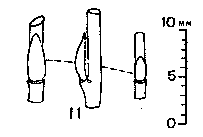 11. Salix livida Whlb. [S. starkeana Willd.] B l u i s h w i l l o w
11. Salix livida Whlb. [S. starkeana Willd.] B l u i s h w i l l o w
A low or medium-sized (1–2 m) shrub occurring at forest edges, in woods, dry meadows, as well as wetlands.
Branchlets 1–1.5 mm, more or less pubescent or, not infrequently, glabrous; mostly red, rarely only rufescent. Stipule scars small, but conspicuous. Two-year-old branches more grayish. Wood in older branches occasionally with striation. Floriferous buds (4–6)×2.5 mm; usually accumbent to branchlets; deltoid-lanceoloid or ovoid-lanceoloid (rarely ovoid); with distinct lateral carinas, more
or less flattened on adaxial side; acutish, occasionally (as rare variation) attenuating into flattened beaks, which adds
to bud length; with or without indumentum. Floriferous bud scales dead, orange-yellow, rufescent, or reddish. Leaf buds up to 3.5 mm long, adpressed to branchlets, ovoid-lanceoloid, more compressed than floriferous ones, of same color as floriferous
ones, leaf budscales also dead. Leaf primordia lanceolate, sericeous on outside (occasionally with greenish indistinct stripes at margins), glabrous on inside. Floriferous
buds usually contain 3–5 leaf primordia. Catkins densely sericeous.
Specimens with pronounced indumentum have been treated as a separate species, S. xerophila Flod., which does not appear justified. Though it is true that plants with more indumentum and with branches of duller and
darker color occur more frequently in the northern and eastern parts of the species range, yet these plants may be only segregated
in an entity in the rank of indistinct geographic race.
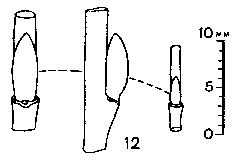 12. Salixpurpurea L. P u r p l e o s i e r, b a s k e t w i l l o w
12. Salixpurpurea L. P u r p l e o s i e r, b a s k e t w i l l o w
A medium-sized to tall shrub (up to 4, but usually 1–2 m) that is mostly confined to banks of water bodies or river flood plains; also found on damp meadows
and moist sand; common in the chernozem belt, much more rare north of the chernozem.
Branchlets 0.6–1.5 mm thick, completely glabrous, smooth, shiny, colored light yellow, grayish-yellow, or grayish-green, at distal parts
often red or blotched red. Stipule scars absent. Two-year-old branches of duller color, older branches light colored. Floriferous buds 5–11 mm long (most often about 7×2.5×2 mm); appressed to branchlets or somewhat deviating, occasionally opposite; ellipsoid
or lanceoloid, not flattened; obtusish (rarely acute), their apices either straight or somewhat curved to branchlets; glabrous
(occasionally glabrescent only at proximal parts), smooth, often shiny. Floriferousbud scales either alive or partially (or completely) dead: alive ones colored red or concolorous to branchlets, typically becoming yellow,
brownish, or blackish when dead. Leaf buds considerably smaller than floriferous ones (their length 2.5–4 mm, width up to 1.5 mm), more flattened, appressed to branchlets,
either yellowish or reddish with yellow spots; leaf budscales alive. Leaf primordia lanceolate, densely sericeous on outside, glabrous on inside. Floriferous buds contain 2–4 leaf primordia. Catkins sericeous, their indumentum not long: bracts occasionally somewhat visible through trichomes.
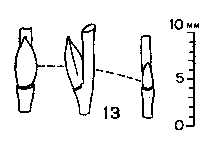 13. Salixrosmarinifolia L. R o s e m a r i n e - l e a v e d w i l l o w
13. Salixrosmarinifolia L. R o s e m a r i n e - l e a v e d w i l l o w
A shrub to 1–1.5 m tall, its multiple slender branches directed straight up, growing in wetlands, turfy meadows, swales within the
steppe belt, as well as on pine-forest sand.
Branchlets to 1 mm thick, sericeous or tomentulose, their glabrous parts colored yellowish, brownish, or reddish-brown. Stipule scars minute or obsolete. Older branches gray, their wood without striation. Floriferous buds up to 6×2.5×2 mm; positioned at acute angle to branchlets (not appressed); ovoid-ellipsoid (not deltoid: their width changing
gradually); lateral carinas mostly obscure, adaxial surface not flattened; typically acute (sometimes obtusish), their apices
either straight or somewhat recurved; sericeous or tomentulose. Bud scales either alive or partially or completely dead: alive ones yellowish in autumn, later mostly reddish-brown, wine-red in transmitted
light, their inner layer red; dead scales gradually turning more brown, their difference from live ones not always distinct.
Leaf buds to 3×1 mm, lanceoloid, flattened. Leaf primordia lanceolate, sericeous on outside, glabrous on inside. Floriferous buds contain 2–3(4) leaf primordia. Catkins sericeous, their indumentum dense but not very long.
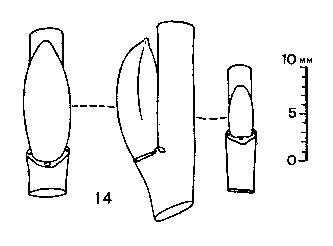 14. Salixdasyclados Wimm. [S. burjatica Nas.] H a i r y w i l l o w
14. Salixdasyclados Wimm. [S. burjatica Nas.] H a i r y w i l l o w
Either a tree or tall shrub growing mostly on banks of water bodies.
Branchlets 2–3 mm thick, clothed with indumentum either entirely or on most of surface; gray velutinous or densely tomentose; glabrous
parts either olivaceous or brownish. Latericious-red lenticels usually conspicuous against indumentum background. Stipule scars conspicuous, sometimes connate with leaf scars. Two-year-old branches grayish or olivaceous, usually with remnant indumentum. Floriferous buds often rather dense, large (9–15×3–5.5×3–5 mm); ellipsoid or lanceoloid, rarely nearly ovoid, not compressed, almost round
on cross section; either obtusish or acutish, their apices either straight or, more often, curved toward branchlets; first
densely pubescent, then loosing pubescence to a variable extent, their glabrous parts tawny-rufescent, with visible dark veins.
Bud scales dry, scarious, dead, often starting to detach already during wintertime. Leaf buds 3–6 mm long, appressed, short lanceoloid or ovoid, more flattened and more obtuse than floriferous buds. Leaf primordia lanceolate, densely sericeous on outside, on inside either glabrous or with trichomes on proximal parts. Floriferous buds
mostly contain 2–3 leaf primordia; occasionally (in males) leaf primordia rudimentary or else constitute structures intermediate
between primordium and bract (similarly as in S. viminalis, S. lapponum, and S. acutifolia). Catkins long, densely sericeous.
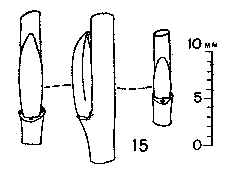 15. Salixgmelinii Teplouch. [S. viminalis L.] O s i e r
15. Salixgmelinii Teplouch. [S. viminalis L.] O s i e r
A tall shrub growing most often near running water and in flood plains. Branchlets 1.2–1.8 mm thick, their indumentum greatly variable, coloration rather closely resembling S. triandra; however, more dull, olivaceous, yellowish, or yellowish-brown, without reddish or bright brown tint. Stipule scars rather small, directly adjacent to leaf scars and often connate with them. Lenticels rufescent. Two-year-old branches glabrous, of lighter colors or grayish. Floriferous buds (5)6–10, most often 7–8 mm long, 2–3 mm broad, 1.5–2.5 mm thick; cylindric or lanceoloid; obtusish or obtuse (rarely acutish),
their apices curved to branchlets; first covered with rather long sericeous trichomes, then often tomentulose or partially
glabrous; either concolorous to branchlets or more rufescent (particularly if bud scales dead). Bud scales alive or dead, their veins, accordingly, light or dark colored, but never conspicuous on outside. Leaf buds 3–5×1.5–2×1 mm, accumbent to branchlets, similar in shape to floriferous buds, but more flattened. Leaf primordia narrowly lanceolate, densely sericeous on outside, glabrous on inside. Floriferous buds mostly contain 2 leaf primordia,
occasionally none. Catkins densely sericeous.
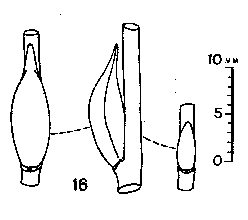 16. Salixlapponum L. L a p l a n d w i l l o w
16. Salixlapponum L. L a p l a n d w i l l o w
Ashrub to 1.5 m tall occurring in wetlands and, in the north of its area, also in wet meadows; extremely rare in the forest-steppe
belt.
Branchlets 1.5–2 mm thick, olivaceous, tawny, or reddish-brown, more or less wooly tomentose; tomentum whitish, occasionally becoming
floccose. Stipule scars in close proximity to leaf scars, sometimes connate with them and then becoming obscure. Two-year-old branches glabrous, colored similarly to branchlets, but lighter. Floriferous buds 7–15×3–5×2.5–4 mm; accumbent to branchlets, or positioned at acute angle, or somewhat deviating sidewards; lanceoloid, not
compressed; their apices attenuating into beaks or at least acutish, either straight or, more often, curved toward branchlets.
Floriferous bud scales dead, canescent, with long tomentum in autumn, later mostly glabrous, brown or rufescent-brown, their dark veins visible
on outside. Leaf buds to 6×2×1 mm, appressed to branches, lanceoloid, acute or obtusish, pubescent, their scales usually alive. Leaf primordia in leaf buds lanceolate, long-sericeous on outside, sparsely and finely sericeous or glabrous on inside. Leaf primordia in floriferous buds lanceolate, counting 3 to 4; or sometimes (in males) triangular, scale-like, approximating bracts. Catkins densely long-sericeous. Bracts with acute apices.
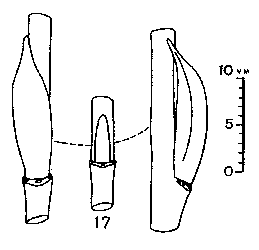 17. Salixacutifolia Willd. P o i n t e d - l e a f w i l l o w
17. Salixacutifolia Willd. P o i n t e d - l e a f w i l l o w
A tall shrub growing on sandy deposits along rivers (becoming rare north of the chernozem belt); favored for cultivation in communities.
Branchlets 1.2–1.8 mm thick, glabrous, olivaceous-green, brownish, or reddish to dark red, covered with bluish bloom that can be easily
rubbed off. Stipule scars inconspicuous (completely connate with leaf scars). Two-year-old branches look similar to branchlets. Floriferous buds large (from 10×2.5×2 to 18×4×4 mm); either appressed to branchlets or somewhat deviating back or sidewards; narrowly lanceoloid,
not compressed (nearly round on cross section); with acute beaks, either straight, recurved, or curved to branchlets; first
with dense indumentum, later often completely glabrous; brown or blackish. Floriferous bud scales dead, scarious, with distinct multiple blackish veins. Leaf buds much smaller, on average 4–5×1.5×1 mm, appressed to branchlets, lanceoloid, either glabrous or with some indumentum. Leaf bud scales either alive, concolorous to branchlets or partially or entirely dead, blackish. Leaf primordia lanceolate, slightly sericeous at margins and on abaxial side or completely glabrous. Floriferous buds either without leaf
primordia or instead contain structures intermediate between leaf primordia and bracts. Catkins densely long-sericeous.
Akimova, N. P. 1950. Kratkiy opredelitel drevesno-kustarnikovykh porod po pochkam. [A concise guide to buds of trees and shrubs.] Kiev
Ilyin, M. M. 1925. Posobiye k zimnim ekskursiyam. Opredelitel derevyev i kustarnikov zimoi. [Manual for winter tours. Guide to trees and shrubs in winter.] Leningrad
Nilson, H. 1908. Vinterknopparna hos släktet Salix ochderas betydelse för artbestämningen. Bot. Notiser.
Opredelitel drevesnykh porod (red. V. N. Sukachev). 1940. [Guide to woody plants (ed. V. N. Sukachev).] Leningrad
Schneider, C. K. 1903. Dendrologische Winterstudien. Jena
Turskiy, M. and L. Yashnov. 1908. Opredelitel drevesiny vetvey i semyan glavneishikh drevesnykh i kustarnykh porod. [Guide to branch wood and seeds of most important trees and shrubs.] Moscow
Wolf, E. L. 1908. Opredelitel po pochkam listvennykh drevesnykh porod. [Guide to buds of leafy trees.] St. Petersburg
Note 1: The author's approach was to distinguish one-, two-year-old, and older 'shoots'. One-year-old shoots here are named 'branchlets' in accordance with the current English usage. Note that during the winter time, branchlets (the youngest branches) are already about one year old. (Translator's note.)
Note 2: Sometimes, pruinose bloom shows up on branches of S. purpurea when a sample is dried, however, there it is much less pronounced.
Note 3: On weak branchlets, S. purpurea, S. cinerea, and S. viminalis, which belong here, may develop small buds, occasionally as small as 5 mm long.
Note 4: One should treat a flat beak in the buds of the next following species (particularly at couplet 11) as an abnormality; if such a beak is present, then it is the content of the bud and not the bud scale that is to be measured.
|
|
|
| Salicicola |
Last updated:
webmaster |